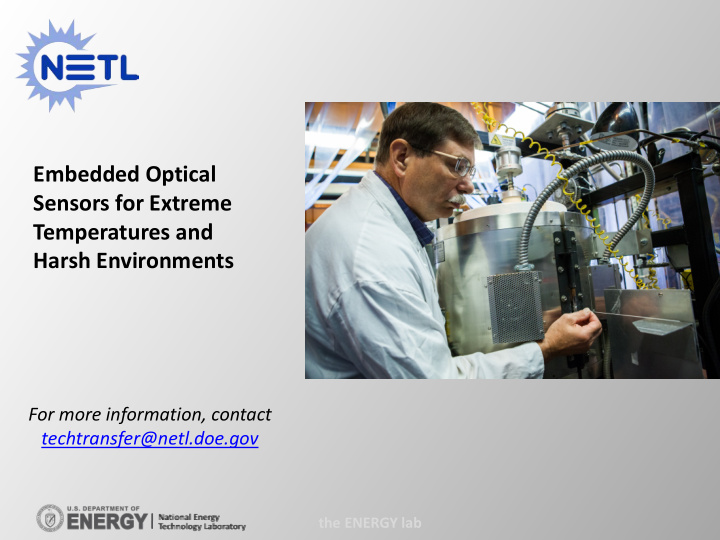



Embedded Optical Sensors for Extreme Temperatures and Harsh Environments For more information, contact techtransfer@netl.doe.gov the ENERGY lab
The Need • Harsh environment sensing in energy applications such as gas composition in gasification, natural gas processing, fuel cells, gas turbines, and other energy conversion systems can help improve efficiency and reduce emissions.
The Problem • These systems are becoming increasingly complex and are subject to harsher environments (higher temperatures and pressures) as energy efficiency is improved and emissions and safety regulations are implemented. • However, there are no commercial solutions available for embedded sensors capable of both chemical and temperature sensing above 500 o C. Solid Oxide Fuel Cell internal gas and temperature distribution
The Competition Traditional Electrical Sensors: prohibitively costly and intrusive • require stable wiring, insulation, electronic components • Complex Optical Sensors expensive • inherent temperature instability issues • Thermocouples Chemi-resistive Sensors RTDs Commercially Available Sensors
The Technology Solution Optical sensors enabled by advanced sensing materials for the embedded sensing of temperature and gas composition in extreme, high temperature environments: Potentially capable of • operation in temperatures approaching 900 o C Minimize or eliminate • wires and electrical contacts at the sensing location Stable, reliable, safe, and • cost-effective Multi-function capability • (gas and temperature) No comparable • commercial sensor on the market!
The Applications • Fossil and Nuclear Power Generation • Oil & Gas • Fuel Cells • Industrial Manufacturing • Aviation • Aerospace • Automotive • Military These sensors would enable unprecedented access to new information in real time
Partnership Opportunity These technologies are available for licensing and/or further collaborative research from the U.S. Department of Energy’s National Energy Technology Laboratory. For more information, contact techtransfer@netl.doe.gov
Recommend
More recommend